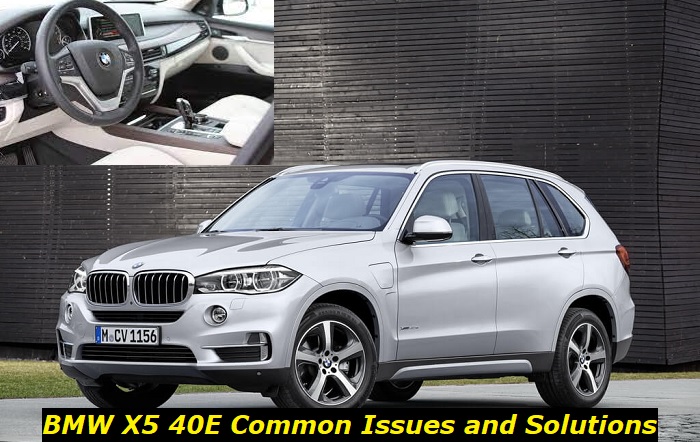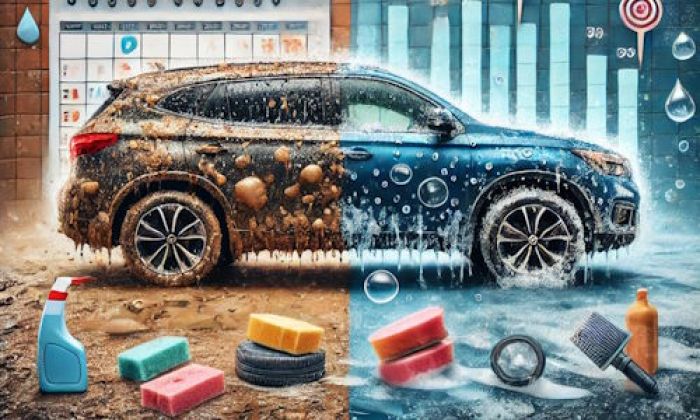No doubt, BMW delivers class by itself, not to mention the excellent drive and technology. X5 40E owners vouch for the vehicle's reliability and ease of maintenance but this popular luxury SUV is not without its problems.
In this article, we'll cover issues common with the BMW X5 40E, especially those with huge repair costs. You will also learn what to do when experiencing these issues to keep your vehicle running smoothly.

BMW X5 40E Problems and How to Fix
Its sleek and tough engine means you get an enjoyable drive with your BMW X5 40E. But you should also know what problems to anticipate with this model and the steps you can take to fix the issue.
Here are 5 common issues that owners have experienced:
1) Water Intrusion
Some X5 40E owners have reported water leaking into the cabin, often as a result of clogged sunroof drains. This problem may also occur when water enters the vehicle's interior through the windows, doors, or other openings, causing damage to the electrical components, upholstery, and other parts of the car.
There are several possible sources of water intrusion in the BMW X5 40E. One common cause is a failure of the vehicle's weatherstripping, which is the rubber or plastic seal around the windows and doors that helps to keep water out. If the weatherstripping is damaged or not properly installed, water can easily enter the car.
Another potential source of water intrusion is the vehicle's sunroof. If the sunroof is not sealed properly, or if it is damaged, water can leak into the car through the opening. And the consequences of water intrusion can be serious.
Water can cause damage to the car's electrical systems, leading to problems with the lights, stereo, and other features. The upholstery and other interior components may also deteriorate or become moldy.
How to Fix
Here is a step-by-step guide on how to fix water intrusion in your BMW X5 40E
- Step 1: Identify the source of the water intrusion
The first step in fixing water intrusion is to determine where the water is coming from. Look for any visible signs of water damage, such as water stains or mold on the interior of your vehicle. Pay particular attention to areas where water can easily enter, such as the windows, doors, and roof.
- Step 2: Check the sunroof
The sunroof is another common source of water intrusion in the BMW X5 40E. If you find that the water is coming from the sunroof, you will need to inspect the sealant and weatherstripping around the sunroof to determine if it is damaged. If it is, you will need to repair or replace it.
2) Stalling Engine
Your X5 40E stalling, while you're driving, can be a dangerous issue and is often linked to a faulty fuel pump and faulty ignition coils.
The fuel pump is responsible for delivering gasoline to the engine, and if it is not working properly, it can lead to engine stalling. Other issues that can cause engine stalling in the X5 40E include a malfunctioning ignition system, a clogged fuel filter, and a faulty mass air flow sensor.
Another possible cause of engine stalling in the X5 40E is a problem with the electronic control module (ECM). The ECM controls various aspects of the vehicle's engine and transmission, and if it is not functioning properly, it can cause the engine to stall.
How to Fix
The first thing you should do when your BMW X5 40E engine stalls is to check the fuel level. If the fuel level is low, simply filling up the tank should resolve the issue.
But if this isn't the problem, the next step is to check the fuel pump. The fuel pump delivers fuel from the tank to the engine, and if it is not functioning properly, the engine may stall. You can check the fuel pump by listening for a humming noise when the key is turned to the "on" position. If you do not hear a humming noise, the fuel pump may be faulty and will need to be replaced.
A malfunctioning ignition system can also cause the BMW X5 40E's engine to stall. This includes the spark plugs, ignition coils, and ignition control module. If one of these components is not functioning properly, the engine may not be able to ignite the fuel, leading to stalling. To fix this issue, replace the faulty component.
3) Overheated Engine
The X5 40E's engine can sometimes run too hot, which can cause damage and reduce its lifespan. This has been linked to faulty thermostats and water pumps.
An overheated engine occurs when the temperature of the engine exceeds its normal operating range.
One of the most common symptoms of an overheated engine is steam coming from under the hood. This is a sign that the engine is working too hard and is unable to dissipate heat effectively. Other signs include a warning light on the dashboard, a high-pitched whine, and a loss of power.
How to Fix
The first step you should take is to pull over to a safe location and turn off the engine. Continuing to drive with an overheated engine can cause serious damage to the engine and other components.
Then check the level of coolant in the radiator and add more If the coolant level is low.
If there are no visible leaks or the coolant level is already full, you may need to replace the thermostat, which regulates the flow of coolant to the engine, and a malfunctioning thermostat can cause the engine to overheat.
Unsure how to fix an overheated engine? Consider taking your BMW X5 40E to a professional mechanic to diagnose the issue and provide a solution.
4) Transmission Troubles
One of the main problems with the transmission on the BMW X5 40E is that it can experience a sudden loss of power. This can happen while driving or even while the vehicle is stationary. This failure in the transmission system can arise from faulty transmission sensors, damaged gears, and worn-out clutches.
Another issue that can arise with the BMW X5 40E transmission is a rough or jerky shift. Here, the transmission struggles to shift gears, which can be caused by a malfunctioning transmission control module or a problem with the transmission fluid.
The BMW X5 40E can also experience leaks in the transmission system, resulting from a faulty seal or damaged transmission lines.
How to Fix
One of the first things to do when trying to fix transmission troubles is to diagnose the problem. You can do this using a diagnostic tool or by simply driving the vehicle and paying attention to any strange noises or behaviors. Some common symptoms of transmission troubles include grinding or slipping gears, difficulty shifting gears, or a delay in shifting.
If the issue is simply a lack of fluid, adding more fluid may be enough to solve the problem. However, if the issue is more serious, such as a damaged transmission component, you may need to replace that component.
Use only high-quality parts and follow the manufacturer's recommended procedures to ensure that the repair is done correctly.
5) Powertrain Problems
Issues with the powertrain are linked to faulty sensors and other components. These parts generate and transmit power to the wheels, including the engine, transmission, and drivetrain. When there are problems with any of these components, it can affect the overall performance of the vehicle.
One common cause of powertrain problems in the BMW X5 40E is the failure of the drivetrain. This component transfers power from the engine to the wheels, and a failure can cause the vehicle to lose traction or even stop moving altogether.
How to Fix
The powertrain of your X5 40e relies on various fluids, including oil, transmission fluid, and coolant, to function properly. Make sure to check the levels of all these fluids and add more as needed. Also, consider having the fluids changed if they are dirty or have not been replaced in a while.
If the fluid levels are fine and the diagnostic codes do not reveal any major issues, you may have a problem with one of the powertrain components. Have those parts inspected by a professional mechanic to determine the specific problem and recommend the appropriate repairs.
Conclusion
From faulty electrical systems to transmission issues, these problems can be frustrating and costly for owners. And with repair prices often reaching thousands of dollars, it can be a financial burden that many are not prepared to handle.
However, remember that these issues are not unique to the X5 40E and can occur in any make or model of vehicle. The key is to stay vigilant and stay up to date with regular maintenance to ensure that you catch and address any potential issues early on before they become major problems with hefty repair costs.
About the authors
The CarAraC research team is composed of seasoned auto mechanics and automotive industry professionals, including individuals with advanced degrees and certifications in their field. Our team members boast prestigious credentials, reflecting their extensive knowledge and skills. These qualifications include: IMI: Institute of the Motor Industry, ASE-Certified Master Automobile Technicians; Coventry University, Graduate of MA in Automotive Journalism; Politecnico di Torino, Italy, MS Automotive Engineering; Ss. Cyril and Methodius University in Skopje, Mechanical University in Skopje; TOC Automotive College; DHA Suffa University, Department of Mechanical Engineering






Add comment